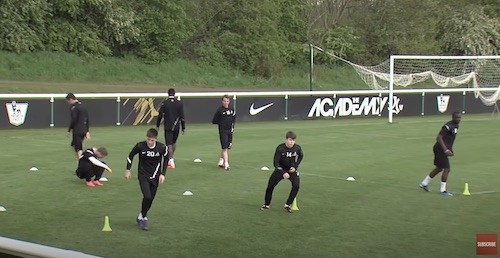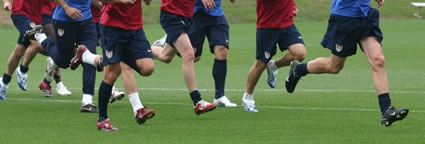| As you may already know, soccer demands an extreme amount of aerobic exercise that gets your heart racing and sweat dripping. But what exactly is aerobic exercise? What are the best cardio workouts for soccer players? How do I get in shape for the coming soccer season through aerobic or cardio workouts?
Want to survive pre-season? How to improve endurance and core strength. Four Four Two can help courtesy of this summer soccer workout from Jon Goodman, performance director for the Nike Soccer Academy. Ask a soccer trainer, and he might say something like this: it’s a type of exercise where muscles rely on oxygen in the blood as an energy source, as well as fats and glucose, for long periods of time. But the key player here is oxygen. Oxygen is needed to burn fats and glucose in order to produce adenosine triphosphate (ATP), which is the primary energy source supplied to your body’s cells. Without a proper oxygen supply, you won’t be able to fuel your body efficiently and you risk serious injury. Aerobic exercise increases heart rate and cardiovascular endurance, so the more aerobic soccer training you get, the more endurance you will build. But there’s a catch. You need to train for a minimum of 20 minutes so that your body can reach and then maintain an increased heart rate. An easy way to get in some aerobic training is through long distance running. After all, most of your time during the soccer game is spent running, so it’s necessary to condition your body for endurance, as well as strength for sudden bursts of speed. You can run just about anywhere there’s a wide-open area, such as along the side of a street, in the park, on a track, or on the beach. Just make sure the area is well lit and that you don’t run for more than 40 minutes to prevent exhaustion or cramping. And keep in mind, running is much more fun when you have a buddy to accompany you! But what exactly are the benefits of running? Long distance running is ideal for several reasons. First, it allows you to endure the great distance you’ll cover during a soccer game. In a typical game, soccer players usually travel between 5.5 and 6.8 miles! That’s a lot of ground to cover, so you’ll need to build up your endurance for that.
DID YOU KNOW? Of the distance commonly traveled in a typical soccer game (5.5-6.8 miles), 2.4 mi are spent jogging, 1.2 miles are used running at a high but not maximum speed, 0.6 mi are spent sprinting, 1.5 mi walking, and 0.3 mi are spent moving backwards. Second, long distance running will keep your body in shape during the off-season when you’re not constantly running up and down the field. You have to use it or lose it, and this means your speed! If you fail to run regularly during the off-season, don’t expect to perform like you did last season. Generally, you should run three times per week during the off-season and once per week during the in-season. Why the difference? Because during the in-season, you already get an aerobic workout just by practicing and playing in games. Third, long distance running strengthens the muscles involved in respiration, and helps the flow of air in and out of the lungs. How does this work? Well, for one thing your heart rate increases dramatically while you run, so your blood vessels dilate to allow more blood to circulate through your body. This happens because blood is what carries oxygen throughout your body, and as your heart rate increases, your body needs more oxygen to accommodate the increased level of activity. In other words, the higher your physical activity level is, the more oxygen you need. And more oxygen means more blood being pumped. Simple, huh? REALITY CHECK: A soccer player’s heart rate increases to 150 beats per minute for the majority of a game. This is where your healthy diet and training will help, because your arteries need to be clear of cholesterol and dilated sufficiently in order to carry all that blood and oxygen. Without either one, you risk serious injury. Fourth, long distance running can help clear the mind and can improve your ability to concentrate and focus. Think of it this way. During most of the day, your senses are constantly bombarded with stimuli from all over the place. Sometimes people can get headaches from all the commotion, or they can simply stress out. That’s why people say they need a moment of peace and quiet. So use running as your moment of peace and quiet. Use this time to reflect on what’s going on in your life, think out a problem, or even vent out some frustration. Running can be a very therapeutic activity, so treat it as such. Learn more: Anaerobic Training – Build Speed and Power |
Aerobic Soccer Training – Cardio
















